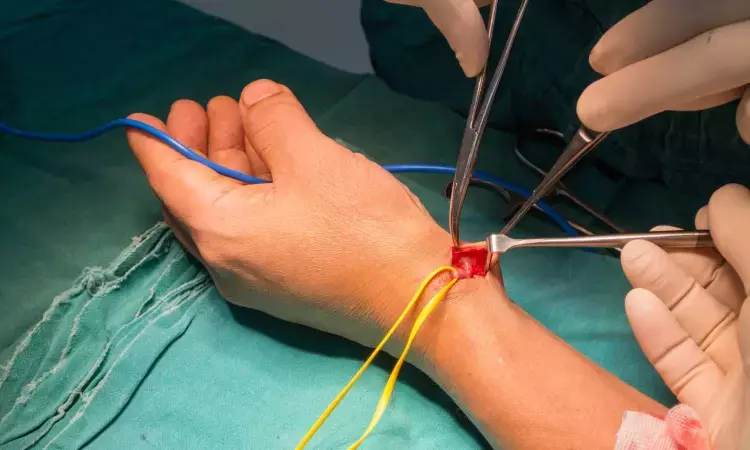- Home
- Medical news & Guidelines
- Anesthesiology
- Cardiology and CTVS
- Critical Care
- Dentistry
- Dermatology
- Diabetes and Endocrinology
- ENT
- Gastroenterology
- Medicine
- Nephrology
- Neurology
- Obstretics-Gynaecology
- Oncology
- Ophthalmology
- Orthopaedics
- Pediatrics-Neonatology
- Psychiatry
- Pulmonology
- Radiology
- Surgery
- Urology
- Laboratory Medicine
- Diet
- Nursing
- Paramedical
- Physiotherapy
- Health news
- Fact Check
- Bone Health Fact Check
- Brain Health Fact Check
- Cancer Related Fact Check
- Child Care Fact Check
- Dental and oral health fact check
- Diabetes and metabolic health fact check
- Diet and Nutrition Fact Check
- Eye and ENT Care Fact Check
- Fitness fact check
- Gut health fact check
- Heart health fact check
- Kidney health fact check
- Medical education fact check
- Men's health fact check
- Respiratory fact check
- Skin and hair care fact check
- Vaccine and Immunization fact check
- Women's health fact check
- AYUSH
- State News
- Andaman and Nicobar Islands
- Andhra Pradesh
- Arunachal Pradesh
- Assam
- Bihar
- Chandigarh
- Chattisgarh
- Dadra and Nagar Haveli
- Daman and Diu
- Delhi
- Goa
- Gujarat
- Haryana
- Himachal Pradesh
- Jammu & Kashmir
- Jharkhand
- Karnataka
- Kerala
- Ladakh
- Lakshadweep
- Madhya Pradesh
- Maharashtra
- Manipur
- Meghalaya
- Mizoram
- Nagaland
- Odisha
- Puducherry
- Punjab
- Rajasthan
- Sikkim
- Tamil Nadu
- Telangana
- Tripura
- Uttar Pradesh
- Uttrakhand
- West Bengal
- Medical Education
- Industry
Subcutaneous nitroglycerin effectively prevents radial artery occlusion in children: JAMA

A new study published in the Journal of American Medical Association showed that subcutaneous nitroglycerin demonstrated efficacy in avoiding radial artery occlusion (RAO) upon catheter removal, indicating its potential therapeutic value in this susceptible group. RAO constituted a significant danger in tiny pediatric patients.
Due to their tiny veins and high risk of vasospasm during catheterization, pediatric patients are more likely to experience postprocedural RAO. Subcutaneous nitroglycerin prevents vasospasm and boosts the success rate of radial artery catheterization, although it is uncertain how it affects the prevention of RAO following catheter removal. Thus, this study assessed the safety and effectiveness of subcutaneous nitroglycerin in preventing RAO.
Pediatric patients under the age of 3 who needed radial artery catheterization during general anesthesia were enrolled in this clinical research, which was carried out at a single tertiary facility. Subcutaneous nitroglycerin (5 μg/kg/0.5 mL) or normal saline (0.5 mL) above the selected radial artery was administered randomly to patients prior to radial arterial catheterization and catheter removal under ultrasound supervision. The reverse Barbeau test with pulse oximetry on the ipsilateral index finger was used to measure the RAO incidence following catheter removal, which was the main result.
Almost, 68 of the 200 pediatric patients that were originally enrolled were removed due to procedural infractions. RAO incidence was lower in the nitroglycerin group than in the control group (25.4% [17 of 67] vs. 73.8% [48 of 65]; P <.001; odds ratio [OR], 0.12; 95% CI, 0.06-0.26; absolute risk reduction, 48.5%; 95% CI, 33.6%-63.4%) in the per-protocol analysis, which included 132 participants (median [IQR] age, 5.5 [2.0-16.6] months; 73 female [55.3%]).
The nitroglycerin group outperformed the control group in terms of the radial artery's perfusion index (mean [SD], 1.37 [1.09] vs 0.65 [0.49]; 95% CI for mean difference, 0.43-1.01; P <.001) and peak blood flow velocity (mean [SD], 13.0 [11.0] cm/s vs 7.4 [9.2] cm/s; 95% CI for mean difference, 2.1-9.1 cm/s; P =.002) following catheter removal. The RAO duration did not significantly differ across groups. There were no localized side effects or hypotension.
Overall, the findings of this randomized clinical trial highlights that in pediatric patients under 3 years old, subcutaneous nitroglycerin injection prior to radial artery catheterization and catheter removal reduced the incidence of RAO following catheter removal.
Source:
Park, J.-B., Ji, S.-H., Kim, E.-H., Lee, J.-H., Kim, H.-S., Kim, J.-T., & Jang, Y.-E. (2025). Subcutaneous nitroglycerin to prevent radial artery occlusion in pediatric patients: A randomized clinical trial: A randomized clinical trial. JAMA Pediatrics. https://doi.org/10.1001/jamapediatrics.2025.3652
Neuroscience Masters graduate
Jacinthlyn Sylvia, a Neuroscience Master's graduate from Chennai has worked extensively in deciphering the neurobiology of cognition and motor control in aging. She also has spread-out exposure to Neurosurgery from her Bachelor’s. She is currently involved in active Neuro-Oncology research. She is an upcoming neuroscientist with a fiery passion for writing. Her news cover at Medical Dialogues feature recent discoveries and updates from the healthcare and biomedical research fields. She can be reached at editorial@medicaldialogues.in
Dr Kamal Kant Kohli-MBBS, DTCD- a chest specialist with more than 30 years of practice and a flair for writing clinical articles, Dr Kamal Kant Kohli joined Medical Dialogues as a Chief Editor of Medical News. Besides writing articles, as an editor, he proofreads and verifies all the medical content published on Medical Dialogues including those coming from journals, studies,medical conferences,guidelines etc. Email: drkohli@medicaldialogues.in. Contact no. 011-43720751


